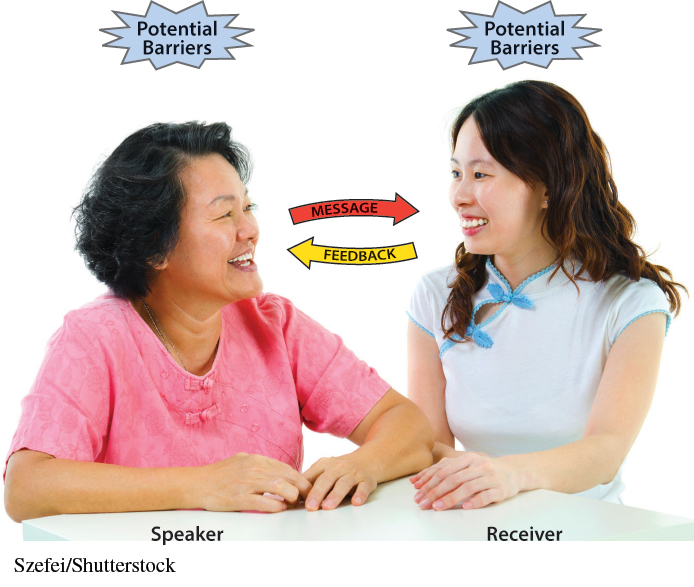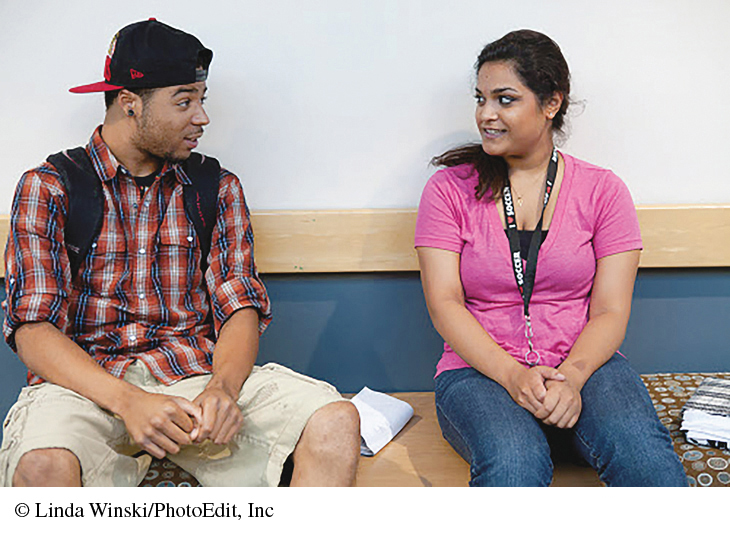Enhance Your Communication Skills
ACTIVITY: A fun way to demonstrate speaking and receiving is to play the game telephone. Whisper a message to a student. Have the student whisper the message to another student, and let the game continue until everyone takes a turn. (The message can be delivered only once each turn.) Usually the message is altered by the time it reaches the last student.
Communication is at the heart of connecting with others. When we communicate, we engage in a back-and-forth exchange that helps us learn information and build relationships with the people around us. In college you’ll communicate with a wide variety of people, in many different situations. Some of the most important conversations will be one-on-one: For example, you might clarify concepts with an instructor, discuss project plans with a classmate, or exchange first-year survival tactics with a friend. Communication experts call this active exchange of information between two people (and sometimes more) interpersonal communication.
Interpersonal Communication: An active exchange of information between two or more people.
Interpersonal communication is a two-way street where each person takes turns speaking and receiving. When you’re the speaker, your goal is to convey your message clearly to the person on the receiving end. When you’re the receiver, your goal is to listen actively to the speaker’s message and to provide short responses called feedback that show you’ve heard and understood the message — or to ask for clarification if you haven’t. (See Figure 11.1.) The roles of speaker and receiver may quickly reverse if the receiver has something more substantial to contribute to the conversation.
In this section we focus on your role as the receiver of information, including how to listen and how to respond when barriers to a conversation prevent you from hearing or understanding the full message. Then we touch on ways you can communicate your message effectively when you’re the speaker — a topic we continue to explore throughout the chapter.

FOR DISCUSSION: Have students recall a recent conversation they had with someone who wasn’t listening to them or was only partly listening. How did they know the other person wasn’t listening? Was it something the person said or didn’t say? How did this make the students feel?
Become a Better Listener
Strange as it may seem, one of the best ways to become a good communicator isn’t to speak — it’s to listen. As we discuss in the chapter on note taking, during active listening you pay close attention to a speaker and focus on his or her message so that you can take accurate, useful notes. In interpersonal communication, active listening demonstrates your respect for others and helps you grasp their meaning when they speak. Active listening involves communicating nonverbally and providing verbal feedback.
CONNECT
TO MY CAREER
Ask a friend or relative to pretend to interview you for your dream job. Shake hands with the “interviewer.” As you answer his or her questions, be mindful of your eye contact, body posture, and body movement. Afterward, ask for feedback on the messages you conveyed nonverbally.
Nonverbal Communication. Your body language says a lot about how well you’re listening to another person, and the following techniques can help you stay engaged and attentive.
Make eye contact. Maintain an appropriate amount of eye contact with the person who’s talking. Preferred levels of eye contact vary according to culture or context, but most Americans prefer eye contact of moderate intensity — enough to show interest, but not so much that the person feels that you’re staring.
Maintain open body posture. Convey attentiveness by using an open posture — face the speaker, sit up straight, relax your shoulders, and keep your arms at your sides or folded in your lap. Avoid any temptation to cross your arms because this closed posture may convey irritation, anger, discomfort, or disagreement with the speaker or his or her message.
Page 257Watch your body movement. Lean slightly toward the speaker to show that you’re ready to listen or want to hear more. Nod occasionally to encourage the person to continue, or to convey your understanding of (or agreement with) what he or she is saying.
Stay focused. Maintain your focus on what the other person is saying; for instance, try not to glance at your phone or give in to other distractions.
FURTHER READING: For more on the impact of nonverbal cues in cross-cultural communication, see the Diversity Council’s tip sheet “Cross-Cultural Communication: Translating Nonverbal Cues.” You can access a PDF of the document with a quick online search.
ACTIVITY: Ask students to people-watch in a public place. Have them observe a conversation and, on a piece of paper, list some of the body movements they see. Then ask students to describe what messages these movements might convey to the other person.
Provide Feedback. In addition to nonverbal communication, you can show that you’re listening to someone and that you understand his or her message by providing verbal feedback.1 Here are several ways to provide feedback effectively.
Give brief encouragement. When used occasionally, brief responses such as “yes,” “uh-huh,” and “okay” indicate that you’re paying attention to the message. (Although when used too frequently, they may give the impression that you want the speaker to hurry up and stop talking.)
Paraphrase. If you summarize or paraphrase what the speaker said by restating it in your own words, you can check your understanding of the message (“So, what I hear you saying is …”).
Manage barriers. Interpersonal communication isn’t perfect, and sometimes barriers — everything from noise to confusion to distractions — can cause communication to break down. To overcome barriers, address them tactfully by asking a follow-up question, providing information, or sharing your own insights (see Table 11.1). You may also contribute to the conversation by helping manage the other person’s emotions and defuse heated situations using emotional intelligence, which we’ll explore later in the chapter.
ACTIVITY: Divide the class into pairs. Have one student talk for three to five minutes, and have the other student listen using nonverbal communication skills. Ask the second student not to talk, only to listen. Have them switch roles. After the activity, ask students to discuss their experience. Was this exercise difficult?
ACTIVITY: Have the class revisit the active listening activity but this time allow the student assigned to listen to give feedback. Then have students switch roles. Ask students to discuss the two experiences. What was it like to have someone listen without speaking? What changed once the listener was allowed to give feedback?
FOR DISCUSSION: Ask students to provide an example of a time when they were the speaker or the receiver and the communication broke down. Ask them to interpret what happened. What were the barriers to communication? Were they able to overcome these barriers and get the conversation back on track?
| Communication barrier | Examples of possible feedback |
|---|---|
| You couldn’t hear what the speaker said because of a loud noise. | “Sorry, but I couldn’t hear what you said. Can you explain again?” |
| You didn’t understand what the speaker said. | “I’m not sure I get what you’re saying. Can you clarify what you mean?” |
| You zoned out for a minute and lost track of the conversation. | “I apologize. I lost focus for a second. Could you repeat what you just said?” |
| The speaker seems distracted. | “I may be wrong, but you seem a bit distracted. Do you want to pick this up later, when things have calmed down?” |
| The speaker is telling you one thing, but his or her expression and body language convey something else. | “I know you’re telling me that everything’s fine, but you look sad.” |

Become a Better Speaker
Feedback shows that you’re listening to a conversation, but what do you do when you want to communicate something more substantial — to become the speaker yourself? Throughout the rest of this chapter we’ll look at specific techniques that will help you express your message thoughtfully, effectively, and honestly — during both pleasant and not-so-pleasant conversations. We begin by discussing emotional intelligence, which you can use to speak with others openly and sensitively.